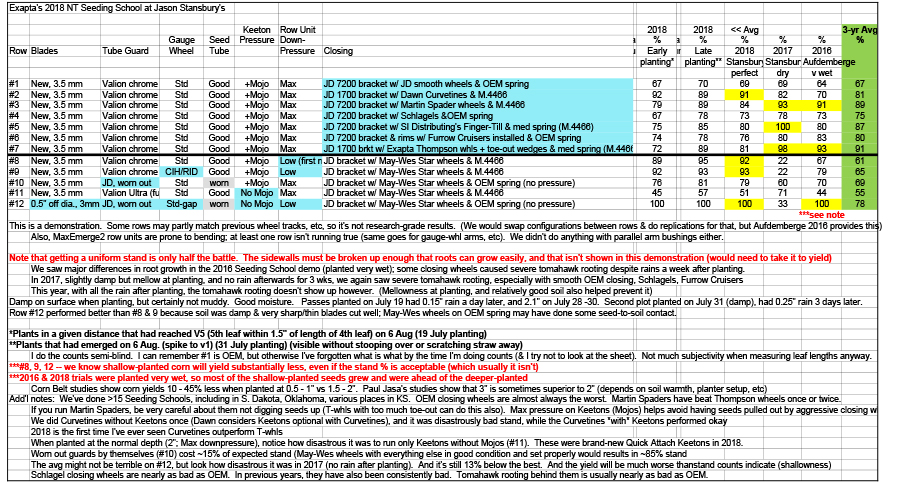Seeding School Results
Exapta’s No-Till Seeding School: planter results
by Matt Hagny
Nearly every year since 2001, we’ve conducted our No-Till Seeding School with the help of farmers—usually in Kansas, but we’ve also done these in Oklahoma & S. Dakota. The demonstrations include different setups and adjustments to various rows on a 12- to 16-row planter—with opportunity to view corn planted a couple weeks prior, and again the day of the event. I’ve always done stand counts and provided that info to participants. But only in recent years did I start compiling that info—and I also improved my methodology so that I was counting the leaves on each corn plant to know whether or not to include it in the stand count or not (very tedious when considering that I usually worked with 80 to 100 feet of row, and 12+ rows), trying to get a sense of uniformity. This eliminated a lot of the fuzziness and subjectivity and made my counts very repeatable (which I sometimes did re-count a row, just to see how much I varied—darned little).
You might still object that these data are gathered by me, with an economic (or psychological) stake in certain products being evaluated. Hence, the potential to bias the results. Let me assure you: First, there’s no subconscious bias, because I’m essentially doing the counts blind—I can’t remember what row what is when I’m doing the counts, except to remember that Row #1 is OEM smooth rubber closing. You might think that I’m fiddling the results afterwards, but I don’t really feel threatened by competitor products when evaluated fairly and scientifically (I’m a much better scientist than a salesman). Indeed, as the president of Exapta, if there are any competitor products outperforming ours, I for dang sure want to know about it so we can improve our product line-up! And those who know me well, often say that I’m brutally honest about everything, including our products.
Now, to the results. I need to emphasize three things: First, this is a demonstration. Were these research-grade results, we would move the variable (the component whose effect we’re trying to measure) between different planter row units during the test, and replicate—in case there was important variation in the performance of the seed meters or base row unit (bent shanks, etc.) that was affecting the outcome. We didn’t do that, but the multi-year results do make use of two entirely different planters, so that helps.
Secondly, this isn’t taken to yield. (If it were, then we’d have to take into account additional variables such as rows being alongside tractor or transport wheels.) Yield is the final word on performance. And yet we know from work done by Ken & Isaac Ferrie, as well as Paul Jasa and others, that stand uniformity is very strongly associated with yield.
Third, the amount of sidewall breakage from closing wheels is important in getting maximum root development. These data don’t capture that (taking it to yield would, but that involves more complexity than we were set up to handle). But where we planted in somewhat muddy conditions in 2016, there were stark differences in the amount of tomahawk rooting amongst the rows. 2017 was damp at planting, but not muddy, and we again saw considerable tomahawk rooting from the smooth OEM closing wheels (which we would expect), as well as the Schlagels and Furrow Cruisers. Almost all rows had some degree of tomahawking, but these particular ones were awful. (You can also catch the video of us inspecting these rooting patterns the day of the School in 2016, on our DVD of that event). No tomahawk rooting was evident in 2018.
As a reminder, you needn’t take our word for any of this. Do your own tests, but please do them for at least two years if not three to see the full range of conditions. And drop us a note to let us know how things turn out!

